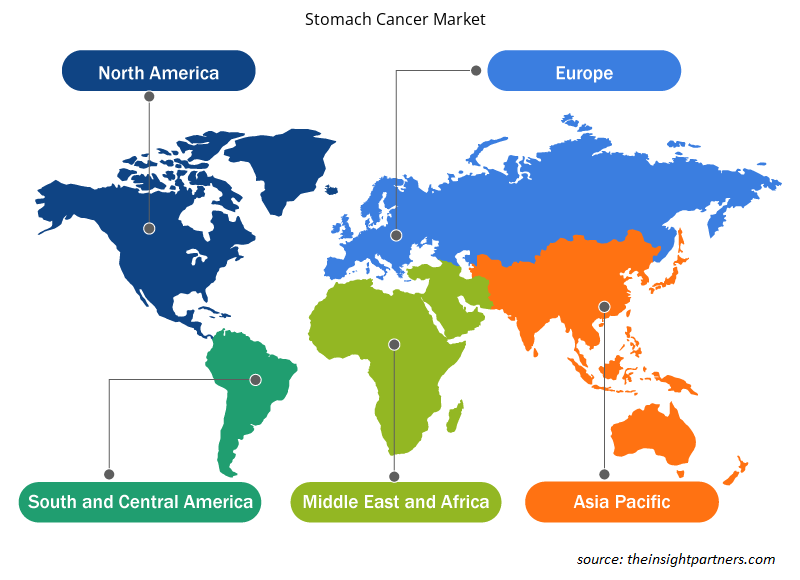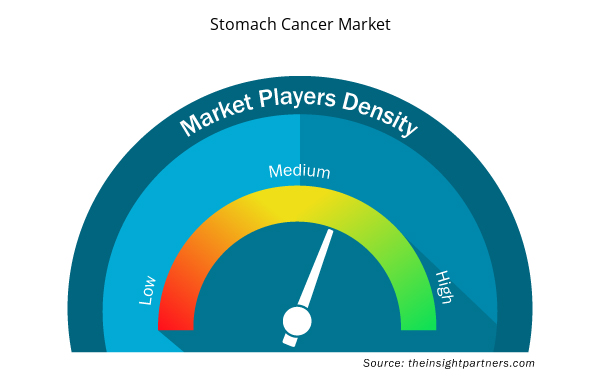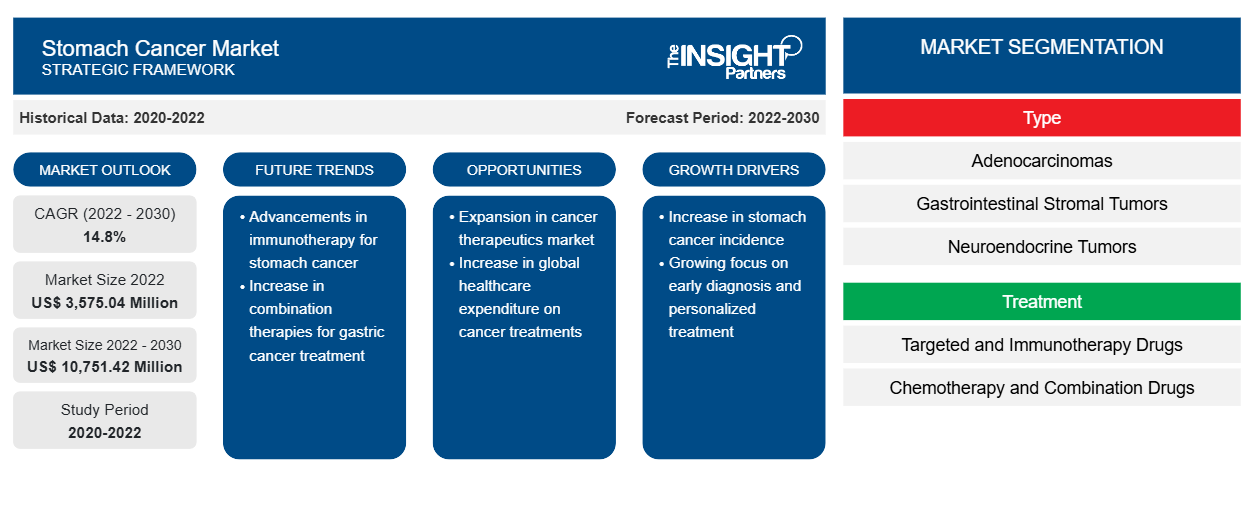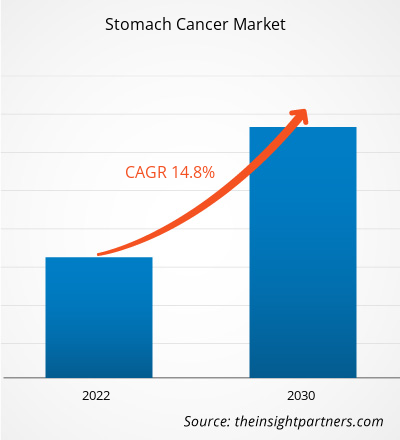[研究报告] 胃癌市场规模预计将从 2022 年的 35.7504 亿美元增长到 2030 年的 107.5142 亿美元;预计 2022-2030 年期间的复合年增长率为 14.8%。CAGR of 14.8% during 2022–2030.
市场洞察和分析师观点:
胃癌又称胃癌,是由胃中恶性细胞异常和失控生长引起的。导致胃癌风险的危险因素包括年龄和食物。消化不良、胃部不适、食欲不振、胃灼热和体重减轻都是胃癌的症状。治疗胃癌的方法多种多样,如化疗、放射疗法和免疫疗法。胃癌市场的增长受到多种因素的影响,例如胃癌发病率的上升、治疗的进步(包括化疗、手术和靶向疗法)以及持续的研发努力以改善患者治疗效果。随着对早期诊断和个性化治疗方法的日益重视,预计未来胃癌治疗市场将继续扩大。
增长动力:
医疗保健市场的企业正在进行各种研发活动,以推出胃癌的创新治疗方法。此外,治疗方法正在临床试验中进行评估,新方法也在通过临床试验不断开发和研究。以下是正在研发的一些产品:
- 2022年12月,浙江多尔生物制品有限公司与默克公司签署了临床试验合作协议,以评估多尔生物的抗Claudin18.2抗体DR30303与默克的抗PD-1疗法KEYTRUDA(帕博利珠单抗)联合治疗胃癌或胃食管交界处癌患者的疗效。根据协议条款,多尔生物根据双方商定并最终确定的方案开展了一项实验研究,以研究DR30303与KEYTRUDA联合治疗Claudin18.2阳性、局部晚期不可切除或转移性胃癌或胃食管交界处癌患者的安全性和有效性。
- 2022 年 11 月,Triumvira Immunologics 公布了其在研 TAC-T 细胞疗法 CLDN18.2-TAC T 和 GUCY2C-TAC T 的临床前数据,以及 HER2 特异性 TAC-T 产品的数据。该公司展示了其针对 Claudin 18.2 的新型 T 细胞抗原偶联剂 (TAC)-T 细胞候选药物的最新数据,该药物用于治疗胃癌。
- 2022 年 9 月,Nuvectis Pharma, Inc. 宣布 NXP800 在 ARID1a 突变胃癌临床前异种移植模型中的阳性数据。在用载体或 NXP800 治疗每组小鼠后,测量了 28 天的肿瘤体积。与对照组相比,NX800 治疗的结果是肿瘤消退和显著的肿瘤生长抑制。
因此,临床试验数量的增加有助于提高全球胃癌治疗的可用性,进而对胃癌市场的增长产生积极影响。
定制此报告以满足您的需求
您可以免费定制任何报告,包括本报告的部分内容、国家级分析、Excel 数据包,以及为初创企业和大学提供优惠和折扣
- 获取此报告的关键市场趋势。这个免费样品将包括数据分析,从市场趋势到估计和预测。
报告细分和范围:
胃癌市场根据类型、治疗、给药途径、分销渠道和地理位置进行细分。根据类型,胃癌市场分为腺癌、胃肠道间质瘤、神经内分泌肿瘤、淋巴瘤等。根据治疗方法,胃癌市场分为靶向和免疫治疗药物、化疗和联合药物等。根据给药途径,胃癌市场分为口服、肠外和其他。在分销渠道方面,胃癌市场分为医院药房、零售药房和网上药房。从地理上讲,胃癌市场分为北美(美国、加拿大和墨西哥)、欧洲(法国、德国、英国、西班牙、意大利和欧洲其他地区)、亚太地区(中国、印度、日本、澳大利亚、韩国和亚太其他地区)、中东和非洲(沙特阿拉伯、阿联酋、南非和中东和非洲其他地区)以及南美洲和中美洲(巴西、阿根廷和南美洲和中美洲其他地区)。
节段分析:
胃癌市场按类型分为腺癌、胃肠道间质瘤、神经内分泌肿瘤、淋巴瘤等。腺癌领域在 2022 年占据了相当大的市场份额,预计在 2022-2030 年期间将在胃癌市场中实现最高的复合年增长率。
根据治疗方法,胃癌市场分为靶向药物和免疫治疗药物,化疗和联合用药等。2022 年,化疗和联合用药领域占据了相当大的市场份额。靶向和免疫治疗药物领域预计将在 2022-2030 年期间在胃癌市场中实现最高的复合年增长率。
根据给药途径,胃癌市场分为口服、肠外和其他。2022 年,口服药物占据了相当大的市场份额,预计在 2022-2030 年期间将录得最快的复合年增长率。
根据分销渠道,胃癌市场分为医院药房、零售药房和在线药房。医院药房部分在 2022 年占据了相当大的市场份额,预计在 2022-2030 年期间将实现最高的复合年增长率。
区域分析:
胃癌市场主要分为北美、欧洲、亚太地区、南美和中美以及中东和非洲。2022 年,北美占据了相当大的市场份额。2022 年,美国在该地区占据了最大的市场份额。北美市场的增长归因于胃癌患病率的不断上升、靶向癌症治疗的采用率不断提高以及癌症研究和治疗中心先进技术的可及性。美国癌症协会预计,2023 年将诊断出约 26,500 例新的胃癌病例(男性 15,930 例,女性 10,570 例)。约 11,130 人死亡(男性 6,690 例,女性 4,440 例)将死于胃癌。北美在减少癌症的先进技术治疗方案的可及性方面已经很发达,企业正在努力与该地区的知名企业竞争。
此外,公司在为胃癌患者开发有效药物方面开展临床试验的活动不断增加,产品发布和批准的增加,预计将推动该地区市场的增长。2021 年 4 月,美国食品药品监督管理局 (FDA) 批准了百时美施贵宝的 Opdivo 与氟嘧啶和含铂化疗联合使用,用于治疗晚期或转移性胃癌和食管腺癌患者。因此,这些因素可能会在预测期内支持该地区的市场增长。
胃癌市场区域洞察
Insight Partners 的分析师已详尽解释了预测期内影响胃癌市场的区域趋势和因素。本节还讨论了北美、欧洲、亚太地区、中东和非洲以及南美和中美洲的胃癌市场细分和地理位置。

- 获取胃癌市场的区域具体数据
胃癌市场报告范围
| 报告属性 | 细节 |
|---|---|
| 2022 年市场规模 | 35.7504亿美元 |
| 2030 年市场规模 | 107.5142亿美元 |
| 全球复合年增长率(2022 - 2030 年) | 14.8% |
| 史料 | 2020-2022 |
| 预测期 | 2022-2030 |
| 涵盖的领域 | 按类型
|
| 覆盖地区和国家 | 北美
|
| 市场领导者和主要公司简介 |
|
胃癌市场参与者密度:了解其对业务动态的影响
胃癌市场正在快速增长,这得益于终端用户需求的不断增长,而这些需求又源于消费者偏好的不断变化、技术进步以及对产品优势的认识不断提高等因素。随着需求的增加,企业正在扩大其产品范围,进行创新以满足消费者的需求,并利用新兴趋势,从而进一步推动市场增长。
市场参与者密度是指在特定市场或行业内运营的企业或公司的分布情况。它表明在给定市场空间中,相对于其规模或总市场价值,有多少竞争对手(市场参与者)存在。
在胃癌市场运营的主要公司有:
- 百时美施贵宝公司
- 诺华公司
- 默克公司
- 礼来公司
- 比奥康
免责声明:上面列出的公司没有按照任何特定顺序排列。

- 了解胃癌市场顶级关键参与者概况
行业发展和未来机遇:
- 2021年1月,阿斯利康与第一三共公司获得美国FDA批准Enhertu用于治疗晚期或转移性HER2阳性胃腺癌成年患者。
竞争格局和重点公司:
百时美施贵宝公司、诺华公司、默克公司、礼来公司、Biocon、梯瓦制药工业有限公司、Celltrion Healthcare Co., Ltd、三星 Bioepis、辉瑞公司和益普生制药是胃癌市场的知名企业。这些公司专注于推出新的高科技产品、改进现有产品和扩大地域范围,以满足全球日益增长的消费者需求。
- 历史分析(2 年)、基准年、预测(7 年)及复合年增长率
- PEST 和 SWOT 分析
- 市场规模价值/数量 - 全球、区域、国家
- 行业和竞争格局
- Excel 数据集


- Advanced Planning and Scheduling Software Market
- Surety Market
- Dealer Management System Market
- MEMS Foundry Market
- Playout Solutions Market
- Equipment Rental Software Market
- Clinical Trial Supplies Market
- Bioremediation Technology and Services Market
- Vision Guided Robotics Software Market
- Hydrogen Compressors Market

Report Coverage
Revenue forecast, Company Analysis, Industry landscape, Growth factors, and Trends

Segment Covered
This text is related
to segments covered.

Regional Scope
North America, Europe, Asia Pacific, Middle East & Africa, South & Central America

Country Scope
This text is related
to country scope.
常见问题
The adenocarcinomas segment dominated the global stomach cancer market and held the largest market share of 45.34% in 2022.
The stomach cancer market majorly consists of the players such include Novartis AG, Pfizer, Inc., Mylan N.V., F. Hoffmann La Roche Ltd., Eli Lilly and Company, Merck & Co., Inc., Teva Pharmaceutical Industries Ltd., Celltrion Healthcare Co., Ltd., Samsung Bioepis and Bristol Myers Squibb Company.
Stomach cancer is one of the leading causes of cancer-related deaths and the fifth most common malignancy worldwide. According to Globocan, around 1.1 million new cases of the disease were diagnosed worldwide in 2020. The increase in disease burden and approval of pipeline candidates are anticipated to propel the growth of the market during the forecast period.
The CAGR value of the stomach cancer market during the forecasted period of 2020-2030 is 14.76%
Global stomach cancer market is segmented by region into North America, Europe, Asia Pacific, Middle East & Africa and South & Central America. North America held the largest market share of the stomach cancer market in 2022.
Increasing lifestyle changes such as smoking and alcoholism, an increase in obesity, and an increasing prevalence of gastroesophageal reflux disease all act as risk factors for gastric cancer.
Trends and growth analysis reports related to Life Sciences : READ MORE..
The List of Companies - Stomach Cancer Market
- Bristol Myers Squibb Company
- Novartis AG
- Merck & Co., Inc.
- Eli Lilly and Company
- Biocon
- Teva Pharmaceutical Industries Ltd.
- Celltrion Healthcare Co., Ltd.
- Samsung Bioepis
- Pfizer Inc.
- Ipsen pharma.
The Insight Partners performs research in 4 major stages: Data Collection & Secondary Research, Primary Research, Data Analysis and Data Triangulation & Final Review.
- Data Collection and Secondary Research:
As a market research and consulting firm operating from a decade, we have published and advised several client across the globe. First step for any study will start with an assessment of currently available data and insights from existing reports. Further, historical and current market information is collected from Investor Presentations, Annual Reports, SEC Filings, etc., and other information related to company’s performance and market positioning are gathered from Paid Databases (Factiva, Hoovers, and Reuters) and various other publications available in public domain.
Several associations trade associates, technical forums, institutes, societies and organization are accessed to gain technical as well as market related insights through their publications such as research papers, blogs and press releases related to the studies are referred to get cues about the market. Further, white papers, journals, magazines, and other news articles published in last 3 years are scrutinized and analyzed to understand the current market trends.
- Primary Research:
The primarily interview analysis comprise of data obtained from industry participants interview and answers to survey questions gathered by in-house primary team.
For primary research, interviews are conducted with industry experts/CEOs/Marketing Managers/VPs/Subject Matter Experts from both demand and supply side to get a 360-degree view of the market. The primary team conducts several interviews based on the complexity of the markets to understand the various market trends and dynamics which makes research more credible and precise.
A typical research interview fulfils the following functions:
- Provides first-hand information on the market size, market trends, growth trends, competitive landscape, and outlook
- Validates and strengthens in-house secondary research findings
- Develops the analysis team’s expertise and market understanding
Primary research involves email interactions and telephone interviews for each market, category, segment, and sub-segment across geographies. The participants who typically take part in such a process include, but are not limited to:
- Industry participants: VPs, business development managers, market intelligence managers and national sales managers
- Outside experts: Valuation experts, research analysts and key opinion leaders specializing in the electronics and semiconductor industry.
Below is the breakup of our primary respondents by company, designation, and region:

Once we receive the confirmation from primary research sources or primary respondents, we finalize the base year market estimation and forecast the data as per the macroeconomic and microeconomic factors assessed during data collection.
- Data Analysis:
Once data is validated through both secondary as well as primary respondents, we finalize the market estimations by hypothesis formulation and factor analysis at regional and country level.
- Macro-Economic Factor Analysis:
We analyse macroeconomic indicators such the gross domestic product (GDP), increase in the demand for goods and services across industries, technological advancement, regional economic growth, governmental policies, the influence of COVID-19, PEST analysis, and other aspects. This analysis aids in setting benchmarks for various nations/regions and approximating market splits. Additionally, the general trend of the aforementioned components aid in determining the market's development possibilities.
- Country Level Data:
Various factors that are especially aligned to the country are taken into account to determine the market size for a certain area and country, including the presence of vendors, such as headquarters and offices, the country's GDP, demand patterns, and industry growth. To comprehend the market dynamics for the nation, a number of growth variables, inhibitors, application areas, and current market trends are researched. The aforementioned elements aid in determining the country's overall market's growth potential.
- Company Profile:
The “Table of Contents” is formulated by listing and analyzing more than 25 - 30 companies operating in the market ecosystem across geographies. However, we profile only 10 companies as a standard practice in our syndicate reports. These 10 companies comprise leading, emerging, and regional players. Nonetheless, our analysis is not restricted to the 10 listed companies, we also analyze other companies present in the market to develop a holistic view and understand the prevailing trends. The “Company Profiles” section in the report covers key facts, business description, products & services, financial information, SWOT analysis, and key developments. The financial information presented is extracted from the annual reports and official documents of the publicly listed companies. Upon collecting the information for the sections of respective companies, we verify them via various primary sources and then compile the data in respective company profiles. The company level information helps us in deriving the base number as well as in forecasting the market size.
- Developing Base Number:
Aggregation of sales statistics (2020-2022) and macro-economic factor, and other secondary and primary research insights are utilized to arrive at base number and related market shares for 2022. The data gaps are identified in this step and relevant market data is analyzed, collected from paid primary interviews or databases. On finalizing the base year market size, forecasts are developed on the basis of macro-economic, industry and market growth factors and company level analysis.
- Data Triangulation and Final Review:
The market findings and base year market size calculations are validated from supply as well as demand side. Demand side validations are based on macro-economic factor analysis and benchmarks for respective regions and countries. In case of supply side validations, revenues of major companies are estimated (in case not available) based on industry benchmark, approximate number of employees, product portfolio, and primary interviews revenues are gathered. Further revenue from target product/service segment is assessed to avoid overshooting of market statistics. In case of heavy deviations between supply and demand side values, all thes steps are repeated to achieve synchronization.
We follow an iterative model, wherein we share our research findings with Subject Matter Experts (SME’s) and Key Opinion Leaders (KOLs) until consensus view of the market is not formulated – this model negates any drastic deviation in the opinions of experts. Only validated and universally acceptable research findings are quoted in our reports.
We have important check points that we use to validate our research findings – which we call – data triangulation, where we validate the information, we generate from secondary sources with primary interviews and then we re-validate with our internal data bases and Subject matter experts. This comprehensive model enables us to deliver high quality, reliable data in shortest possible time.


 获取此报告的免费样本
获取此报告的免费样本